With the permission of the Ministry of Education of the People’s Republic of China, XUST got two Chinese-foreign cooperatively-run teaching project successfully. The project, “Undergraduate education program in civil engineering held by XUST and University of Tasmania, Australia(UTAS)”,which got the permission in 2014 starts enrolling new students in 2014.
The second project of XUST called “ Undergraduate Education Program in Electrical and control engineering held by XUST and Macquarie University, Australia”which got the permission in 2015 starts enrolling new students in 2016.
Both two projects uses ‘4+0’and ‘2+2’pattern, inducing high qualified educational resources from universities in Australia, cultivating complex engineering management technical students who are capable of speaking English and Chinese in work and have international horizons.

Brief Introduction of XUST
Located in famous historical ancient city Xi’an, XUST’s YangTa campus is close to well-known Big Goose Pagoda while LingTong campus is close to HuangQi Hot Spring and the Museum of Terra Cotta Warriors and Horses renowned at home and abroad. In the assessment of the graduate education done by the Ministry of Education in 2004, XUST was rated as extraordinary and later awarded the title of the “Civilized Campus” of Shaanxi province and that of “ Garden Campus ”.
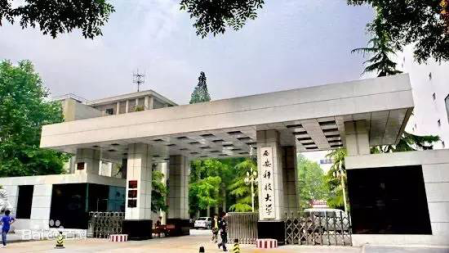
YanTa Campus of XUST
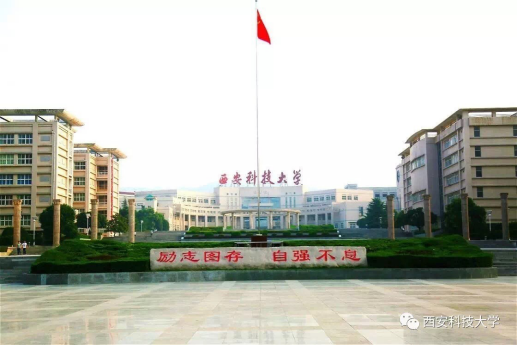
LongTong campus of XUST
Possessed of a deep and profound foundation, Xi’an University of Science and Technology is rich in history, which could trace its origin to the department of Mining and Metallurgy, a branch of the Peiyang University Science College founded in 1895. Having been transferred and later merged into the Mining department of Northwest Institute of Technology in 1938, the predecessor of XUST was then annexed into the Xi’an Jiaotong University in 1957. With the establishment and independence of Xi’an Mining College from Xi’an Jiaotong University in 1958, it was one of the two five-year undergraduate institutions at the time. Pursuing the policy ---Pairing with the central for Construction, Revolving around the local management, the college was ordered to be under the charge of Shaanxi province and was renamed as Xi’an Institute of Technology in 1999. In 2003, it was denominated as Xi’an University of Science and Technology.
With two campuses respectively situated in Lingtong and Goose Pagoda wards, XUST covers a total area of 1.08 million square kilometers and holds 18 colleges for undergraduates and one for graduates. Boasting one national key discipline---the Safety Practice and Engineering, eight disciplines with provincial advantages together with 45 second-rate disciplines, XUST contains numerous highly advanced laboratories, including the National energy and coal division clean transformation Laboratory, National coal and Mining industry Laboratory, and another 13 provincial research platforms such as the western research center for coal security. Apart from the labs, the academic power of XUST is strong: one innovative group of the Ministry of Education, eight nationally special disciplines, 11 disciplines of provincial rate, one national key course, one national key sharing course, 25 key courses of Provincial rate, 62 key sharing courses of provincial rate and two courses of provincial bilingual teaching modals. Since the “the eleventh five-year” plan, XUST has achieved two national teaching prizes because of the efforts from one national teaching group, 28 provincial teaching groups, one national experiment area for cultivating talents and two national centers for teaching research.
Brief Introduction of Foreign Universities
University of Tasmania, Australia(UTAS)
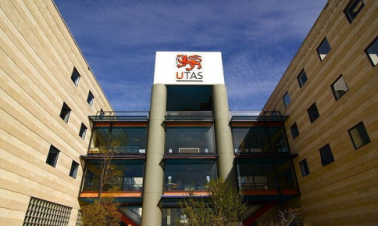
three advantages of studying in UTAS
² first:Graduates get a high starting salary
Average salaries for college graduates in Australia is 52,500 Australia dollars. And the starting salary for graduates in UTAS is 57,547 AUD which is in the top ten of it.
² Second:good for immigration
To encourage international students studying in remote area and promoting local economy, Immigration Office announces that As long as international students could study in there for 2 years, they could get an additional bonus of 5 points for immigration. And UTAS is included.
² Third:good balance for study and work
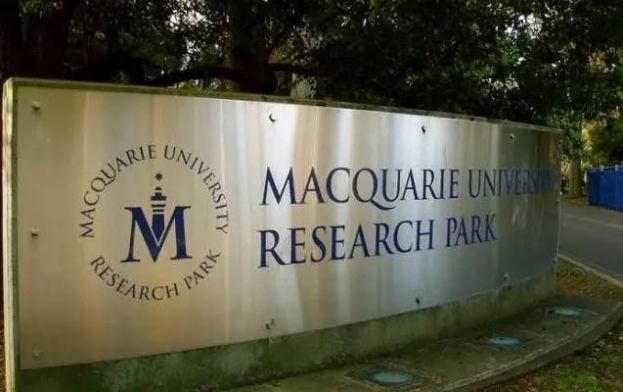
Macquarie University (MU)
Macquarie University is one of the world’s top 2 percent and Australia’s top 10. In the QS world university rankings, MU in accounting and finance professional, communication and media professional, earth and ocean science, geography, education, English language and literature, philosophy and psychology and other professional ranks of the world’s top 100.
Established in 1964, the names of MU is named by “the father of Australia,” Lachlan Macquqrie who was the governor. MU is known for its cross scientific research, education teaching quality, the quality of graduates, and the world first-class scientific research and teaching facilities.
The university has five colleges, led by the President, professor s. Bruce Dowton. At the same time, the innovation center of MU provides the most advanced research facilities in Australia for students, researchers, experts and partners to help them achieve outstanding research results.
Recently, MU invested 1 billion AUD to upgrade the school infrastructure, and provided the most advanced high-tech equipment and facilities, such as design, establishment of international leading Macquarie university library for students and researchers.
² The top two percent universities in the world, the top 10 universities in Australia (academic ranking of Shanghai jiaotong university, 2015)
² All categories of QS university are five-star (QS2015: education, employment, scientific research, internationalization, teaching facilities, innovation, etc.)
²The world’s most international university ranks the 49th (The Times higher education supplement, 2016)
²The top 100 universities in the world rankings of the nine major disciplines (QS rankings, 2015)
² The MBA ranking is No.1 in Australia and No.68 in world.
Brief Introduction of XUST Colleges
College of Civil and Architectural Engineering
There are 135 faculty members, including 15 professors, 32 associate professors, 10 doctoral supervisors, 36 master supervisors and 57 doctoral teachers. Currently eight people obtain special government allowances, 2 people as famous teachers in shaanxi, 3 were selected provincial cross-century talented person, one attains “shaanxi youth shock worker”, 1 was awarded “the advanced individual of young teachers teaching in Shanxi Province", one was awarded “youth science and technology star of shaanxi province”, and one person won the nomination of “national coal youth May 4th medal”. Geotechnical engineering was awarded “national advanced collective coal industry”.
The college has perfect, advanced facilities for teaching and scientific research, with one national virtual simulation experiment teaching center, one key laboratory of the ministry of education, one shaanxi key laboratory, one shaanxi experimental teaching demonstration center, one civil engineering experimental training center, one water supply and drainage science and engineering experiment training center, and 11 professional laboratories and a training center. Professional labs are established and implemented the “scientific comprehensive infiltration of undergraduate course teaching” which is the mechanism of open laboratory, providing an important platform for the practice and research to civil engineering professional talent training. All kinds of science and technology competition activities which actively carried out, has achieved fruitful results.
College of Electrical and Control Engineering
The college of electrical and control engineering has four departments -- automation, electrical engineering, measurement and control technology, electronic technology, and two centers -- electrical and electronic center, and experimental center. There are four major in fields of automation, electrical engineering and automation, measurement and control technology and instrument and microelectronic science and engineering. Among them, automation is the national specialty construction site. Since 1984 when XUST had a master degree in power transmission and automation, the disciplines what the college has now are one mine mechanical and electrical engineering doctoral degree, two control science and engineering master degree, two electrical engineering masters degree, two power electronics and power transmission master degree, ten masters degrees like control theory and control engineering, control engineering, instrumentation engineering, and electrical engineering master degree.
The college has more than 1,800 undergraduate students and 592 graduate students (including 286 engineering masters). There are over 110 faculty members, including 40 ones who own senior professional titles, 5 who own doctoral supervisors. And more than 50 percent of teachers have doctoral degrees.
Educational Qualification
Both cooperatively-run projects are approved by the ministry of education
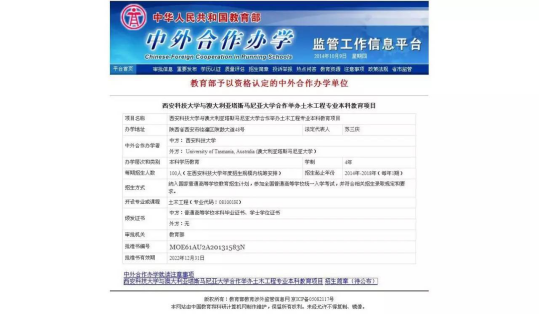
The approving certificate of undergraduate education project of civil engineering major ran jointly by XUST and UTAS
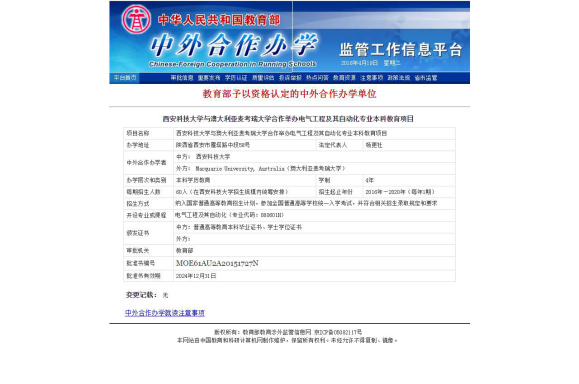
The approving certificate of undergraduate education project of Electrical and Control Engineering major ran jointly by XUST and MU
Cultivating Mode
“4+0”Mode
The program of talent training is jointly formulated and implemented by the two universities in China and Australia. The students have to complete four years of study in XUST, and the management of students’ membership is implemented in accordance with the regulations of XUST. The students who get the qualified grades and pass the graduation design and thesis could be awarded bachelor degree in engineering. Foreign resources are introduced in the course of teaching, which means that a third of the courses are taught by teachers from Australian universities. At present, the project is working well, and the two sides have a pleasant cooperation, and the teaching management and quality control are standardized and orderly.
“2+2”Mode
The student who meets the requirements of Australian universities and obtains a visa to Australia, can study in Australia for two years. During the period of studying two years in China, the training program will be operated jointly by the two universities, which is jointly taught by Chinese and foreign teachers, bilingual teaching. While during the two years of studying abroad, the training program will be operated by Australia Universities, which is taught by Australia teachers. The two sides will conduct course docking, and the agreement will stipulate mutual recognition of course credits. Two degrees, or normal higher education undergraduate diploma and Bachelor’s degree certificate of XUST, and Bachelor’s degree certificate of MU are awarded to graduates who are qualified.
Project Characteristics
² Establish two joint training programs:Introducing foreign excellent education resources, promoting the construction of international curriculum system, setting up non-teaching objectives and introducing 12 teaching methods in English, and international teaching methods.
² Promote the cultivation of bilingual teachers: The two programs will send two teachers each year to study professional courses in Australian universities and colleges, and they will return to China as foreign teachers’ assistants. The project provides a good way of training bilingual teachers.
² Improve satisfactions of students:XUST shall hold meetings of regular project work to resolve the opinions of students and parents in the process of running the project, and strictly follow the recruitment publicity content to ensure objective information and satisfaction of students. XUST strives to provide high quality service for the students who join the project, and to build “Macao cultural exchange center”for students to directly interact with Australian “cloud platform”. Besides, XUST has set special funds for students from chinese-foreign cooperatively-run projects, and has organized vacation trips for them to Australia. The students also recruit members to set up a volunteer team and regularly hold various activities such as “English corner” and other activities of cultural communication.
² Emphasize on cultivating practice ability:In both two projects, the foreign universities attach great importance to the students’ practice ability. the advantages of our university from Australia, formed both attach importance to theoretical knowledge, and pay attention to personnel training mode of cultivating the ability of practice. So XUST drawing on the advantages of Australian schools, has formed a talent training mode that attaches both theoretical knowledge and practice ability.
Requirements of Applying
² Get all the credits required by the major
² Pass XUST special English exam
About Fee
² During domestic study, tuition fees is RMB 22,000 yuan per year; while during the study abroad, tuition fees of studying in the university of Tasmania is about 28,500 Australian dollars/year, and tuition fee of study in Macquarie university is about 31,000 Australian dollars per year.
² Fees of accommodation, life, insurance, overseas examination, visa and other expenses are not included.
Living in Australia
Australia is called the commonwealth of Australia. With a territorial area of 7,686,850 square kilometers and surrounded by sea, it is the only country in the world that covers the entire continent. Australia is a multicultural immigrant country with many unique flora and fauna and natural landscapes.
About Accommodation
² Uni-lodge
The cost of university lodge is generally high, and it is required to pay one semester of accommodation which is about 250 Australian dollars a week. If you are unsatisfied, you can’t change it.
² Homestay
The cost of homestay is suitable which is about 250 Australian dollars a week, including two meals. Application is quick and easy. You can fit in with your local family, and experience true foreign life and culture. In case of dissatisfaction, the homestay can be changed only two weeks in advance through the way of telling your landlord.
² Renting House
The cost of renting house is relatively low which is about 100 - 150 Australia dollars a week. However, you could share a house with other students when you are living in Australia for a while and familiar with your surroundings. But we don’t recommend you to do this at the first beginning.
2017 Admission Plan
2017 Admission Plan of Chinese-Foreign Cooperatively-Run Teaching Project and Enrollment Mark within Two Years
Province
|
Batch
|
Major
|
2017
Admission plan
|
2016
|
2015
|
Score line
|
Minimum
|
Average
|
Score line
|
Minimum
|
Average
|
An Hui
|
first
|
Electrical and Control Engineering(cooperatively-run)
|
3
|
518
|
567
|
568.5
|
|
|
|
Civil engineering(cooperatively-run)
|
3
|
518
|
579
|
584.5
|
555
|
573
|
583.7
|
Fu Jian
|
first
|
Electrical and Control Engineering(cooperatively-run)
|
2
|
465
|
491
|
491.5
|
|
|
|
Civil engineering(cooperatively-run)
|
3
|
465
|
493
|
495.5
|
525
|
556
|
573.0
|
Gan Su
|
Second
|
Electrical and Control Engineering(cooperatively-run)
|
2
|
435
|
497
|
497.6
|
|
|
|
Civil engineering(cooperatively-run)
|
2
|
435
|
493
|
494.1
|
|
|
|
Guang Zhou
|
Second
|
Electrical and Control Engineering(cooperatively-run)
|
2
|
402
|
491
|
491.9
|
|
|
|
Civil engineering(cooperatively-run)
|
4
|
402
|
491
|
495.3
|
519
|
551
|
562.2
|
Guang Xi
|
Second
|
Electrical and Control Engineering(cooperatively-run)
|
2
|
|
|
|
|
|
|
Civil engineering(cooperatively-run)
|
2
|
333
|
443
|
449.5
|
|
|
|
Gui Zhou
|
first
|
Electrical and Control Engineering(cooperatively-run)
|
2
|
|
|
|
|
|
|
Civil engineering(cooperatively-run)
|
2
|
473
|
501
|
510.6
|
|
|
|
Hai Nan
|
first
|
Electrical and Control Engineering(cooperatively-run)
|
2
|
|
|
|
|
|
|
Civil engineering(cooperatively-run)
|
2
|
602
|
618
|
623.1
|
|
|
|
He Bei
|
In Advance
|
Electrical and Control Engineering(cooperatively-run)
|
2
|
|
|
|
|
|
|
Civil engineering(cooperatively-run)
|
3
|
525
|
524
|
532.3
|
474
|
520
|
527.5
|
He Nan
|
first
|
Electrical and Control Engineering(cooperatively-run)
|
3
|
523
|
533
|
539.9
|
|
|
|
Civil engineering(cooperatively-run)
|
4
|
523
|
537
|
541.1
|
529
|
537
|
538.8
|
Hu Bei
|
first
|
Electrical and Control Engineering(cooperatively-run)
|
2
|
|
|
|
|
|
|
Civil engineering(cooperatively-run)
|
3
|
512
|
557
|
559.8
|
510
|
534
|
536.6
|
Hu Nan
|
first
|
Electrical and Control Engineering(cooperatively-run)
|
2
|
517
|
521
|
528.3
|
|
|
|
Civil engineering(cooperatively-run)
|
3
|
517
|
523
|
523.1
|
526
|
542
|
549.7
|
Ji Lin
|
Second
|
Civil engineering(cooperatively-run)
|
2
|
|
|
|
|
|
|
Jiang Su
|
Second
|
Electrical and Control Engineering(cooperatively-run)
|
3
|
315
|
342
|
342.0
|
|
|
|
Civil engineering(cooperatively-run)
|
4
|
315
|
341
|
342.0
|
310
|
333
|
337.3
|
Jiang Su
|
first
|
Electrical and Control Engineering(cooperatively-run)
|
2
|
529
|
545
|
546.6
|
|
|
|
Civil engineering(cooperatively-run)
|
3
|
529
|
547
|
547.5
|
540
|
549
|
549.5
|
Liao Ning
|
Second
|
Civil engineering(cooperatively-run)
|
2
|
373
|
439
|
440.1
|
|
|
|
Hei Long Jiang
|
Second
|
Civil engineering(cooperatively-run)
|
2
|
|
|
|
|
|
|
Nei Meng Gu
|
first
|
Electrical and Control Engineering(cooperatively-run)
|
2
|
484
|
516
|
521.0
|
|
|
|
Civil engineering(cooperatively-run)
|
2
|
484
|
490
|
502.0
|
464
|
505
|
507.5
|
Ning Xia
|
first
|
Electrical and Control Engineering(cooperatively-run)
|
2
|
465
|
504
|
511.7
|
|
|
|
Civil engineering(cooperatively-run)
|
2
|
465
|
506
|
528.2
|
|
|
|
Qing Hai
|
first
|
Electrical and Control Engineering(cooperatively-run)
|
2
|
416
|
425
|
427.5
|
|
|
|
Civil engineering(cooperatively-run)
|
2
|
416
|
437
|
437.0
|
|
|
|
Shan Dong
|
first
|
Electrical and Control Engineering(cooperatively-run)
|
3
|
537
|
563
|
571.5
|
|
|
|
Civil engineering(cooperatively-run)
|
4
|
537
|
568
|
570.1
|
562
|
575
|
577.9
|
Shan Xi
|
Second
|
Electrical and Control Engineering(cooperatively-run)
|
3
|
438
|
511
|
517.1
|
|
|
|
Civil engineering(cooperatively-run)
|
4
|
438
|
508
|
510.7
|
442
|
514
|
514.1
|
Shaan Xi
|
first
|
Electrical and Control Engineering(cooperatively-run)
|
8
|
470
|
479
|
487.0
|
|
|
|
Civil engineering(cooperatively-run)
|
16
|
470
|
479
|
483.3
|
480
|
486
|
496.2
|
Si Chuan
|
first
|
Electrical and Control Engineering(cooperatively-run)
|
2
|
532
|
579
|
588.4
|
|
|
|
Civil engineering(cooperatively-run)
|
4
|
532
|
577
|
585.1
|
528
|
554
|
560.1
|
Tian Jin
|
Second
|
Civil engineering(cooperatively-run)
|
2
|
424
|
453
|
471.6
|
459
|
494
|
497.6
|
Xin Jiang
|
Second
|
Civil engineering(cooperatively-run)
|
2
|
|
|
|
381
|
425
|
429.6
|
Electrical and Control Engineering(cooperatively-run)
|
2
|
|
|
|
|
|
|
Yun Nan
|
first
|
Electrical and Control Engineering(cooperatively-run)
|
2
|
525
|
544
|
546.0
|
|
|
|
Civil engineering(cooperatively-run)
|
3
|
525
|
532
|
544.6
|
|
|
|
Zhe Jiang
|
Second
|
Civil engineering(cooperatively-run)
|
3
|
|
|
|
428
|
540
|
540.0
|
Electrical and Control Engineering(cooperatively-run)
|
3
|
|
|
|
|
|
|
Chong Qing
|
first
|
Electrical and Control Engineering(cooperatively-run)
|
2
|
525
|
541
|
541.2
|
|
|
|
Civil engineering(cooperatively-run)
|
2
|
525
|
528
|
528.7
|
573
|
574
|
578.6
|
Connect Us
Admission Hotline:029-85583041(admission office)
029-85583033(International and Exchange Office)
Address:No.58, YanTa Road, BeiLin District, Xi’an City, Shannxi Province
Postcode:710054